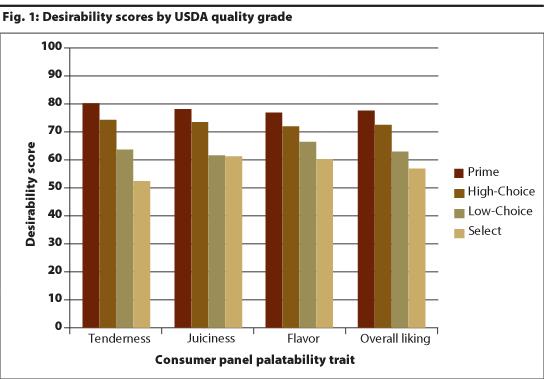Beef Consumers and Flavor
When it comes to food, the alternatives are endless: spicy or bland; Mexican, Italian, Asian or Southern-style comfort dishes. But when it comes to beef, almost everyone agrees on a few features.
"Consumers tell us that higher fat levels are more desirable; they like it better," says Mark Miller, meat scientist at Texas Tech University. "We've found that marbling level has a really big impact on the consumer's desire for beef."
He referenced a thesis by Travis O'Quinn, "Consumer Acceptance of Beef Strips," comparing strip loins from USDA Prime to Select, where overall liking declined from 95.8% to 79%. That linear downtrend mirrored the flavor ratings, which showed 97.5% of the Prime steaks were acceptable. Those scores dropped with each successive grade break: 94.2% for high-Choice, 92.4% for low-Choice and 85.8% for Select.

"Overall liking was most highly correlated with flavor," the thesis states, but tenderness and juiciness ratings followed similar patterns.
"That shows why the CAB® [Certified Angus Beef®] brand is so effective. It has increased all that market share based on flavor," Miller says.
Consumers rated each steak with a "perceived quality level," such as unsatisfactory, good everyday quality, better than everyday quality and premium quality.
For Prime, 35.8% called it "premium quality" and 34.2% said it was "better than everyday quality," for a combined total 71% above average.
High-Choice had 55.8% in those two upper categories, compared to Select at just 29.2%.
The USDA quality grades do their job, Miller says.
"They're based on what will give you the ultimate level of consumer satisfaction," he says. Juiciness is controlled by degree of doneness, so that leaves flavor and tenderness. Since quality grades include a maturity component, that helps with the latter.
"On top of that we use marbling, a factor that's tremendously related to all three," he says.
Research a decade ago showed tenderness contributed half of overall beef eaters' satisfaction, followed by flavor at 40%.
"Tenderness is by far the most important factor, but once a steak meets a consumer's threshold for tenderness, then flavor becomes the sole driver," Miller says, explaining flavor was a main focus in the latest study.
Surveys reveal more than 91% of the beef in today's retail case meets tenderness expectations.
"Tenderness is the most important factor, and we need to keep on top of it — we need to keep surveying and monitoring it. We need to keep progressing," he says. "But flavor is an area where we can make a lot of progress on our competition, especially in the international market."
The Texas team is already into research that digs deeper.
"We've been working to characterize not only what it is that makes flavor important in beef, but trying to identify the individual compounds that make a difference," Miller says, noting collaborative projects in Australia and Ireland.
Using instruments to analyze the chemical makeup of the aroma that wafts off from varying qualities of steaks, for example, may help meat scientists determine what's behind taste at different marbling levels.
"The take-home for cattlemen is we have a product that we need to keep improving so we can give it the flavor, juiciness and tenderness that the consumer wants," he says.













